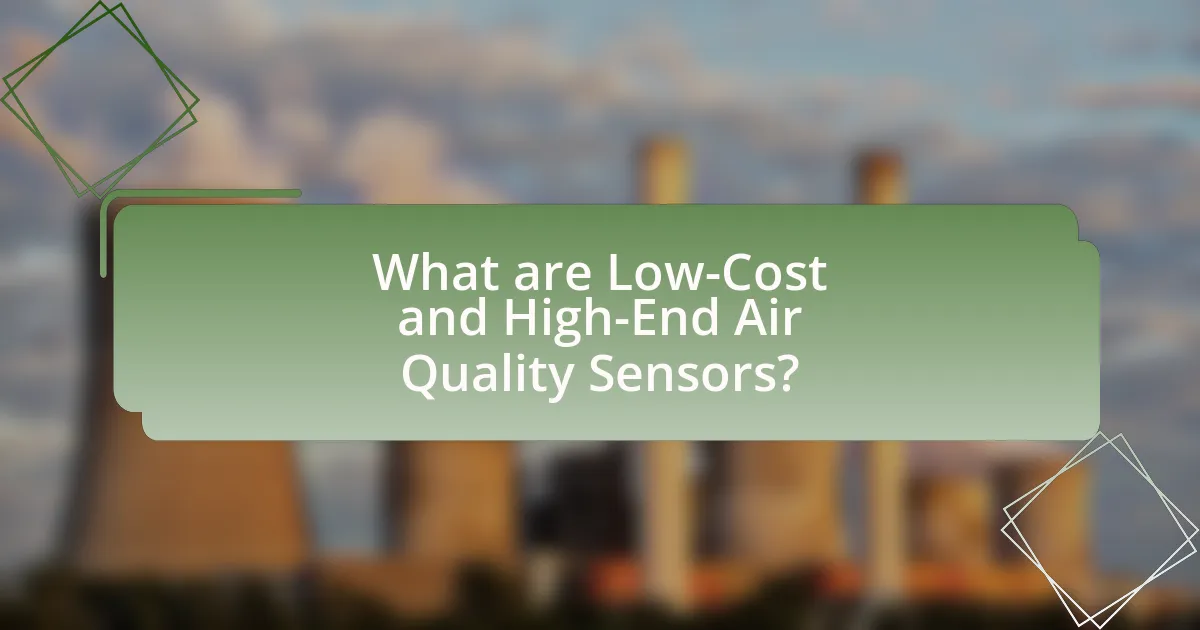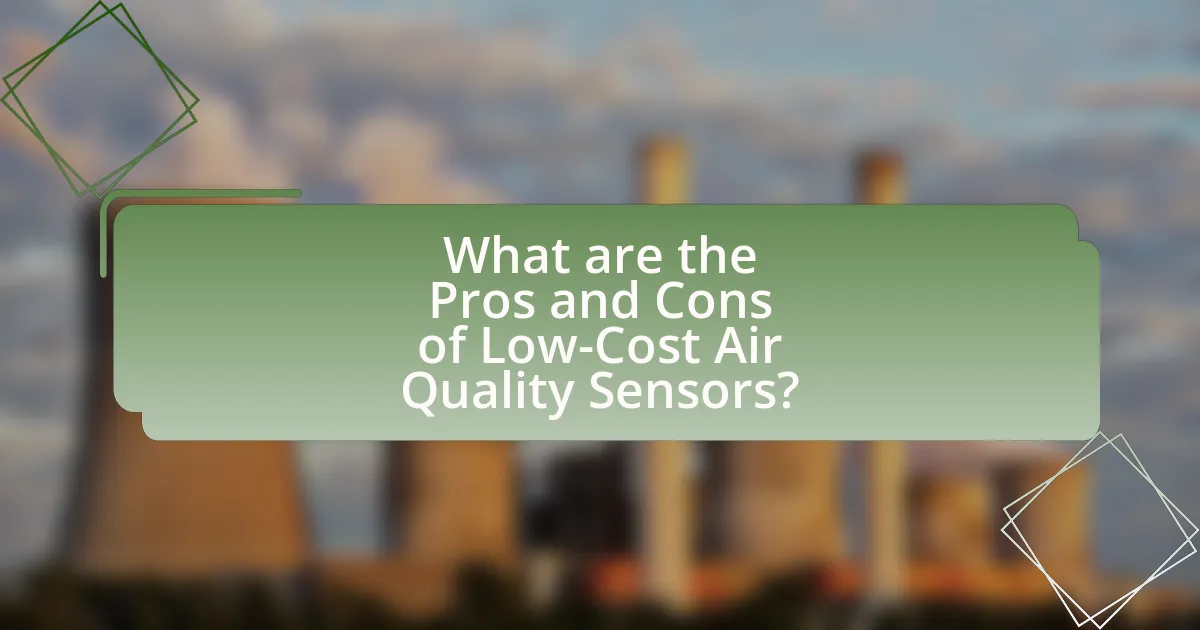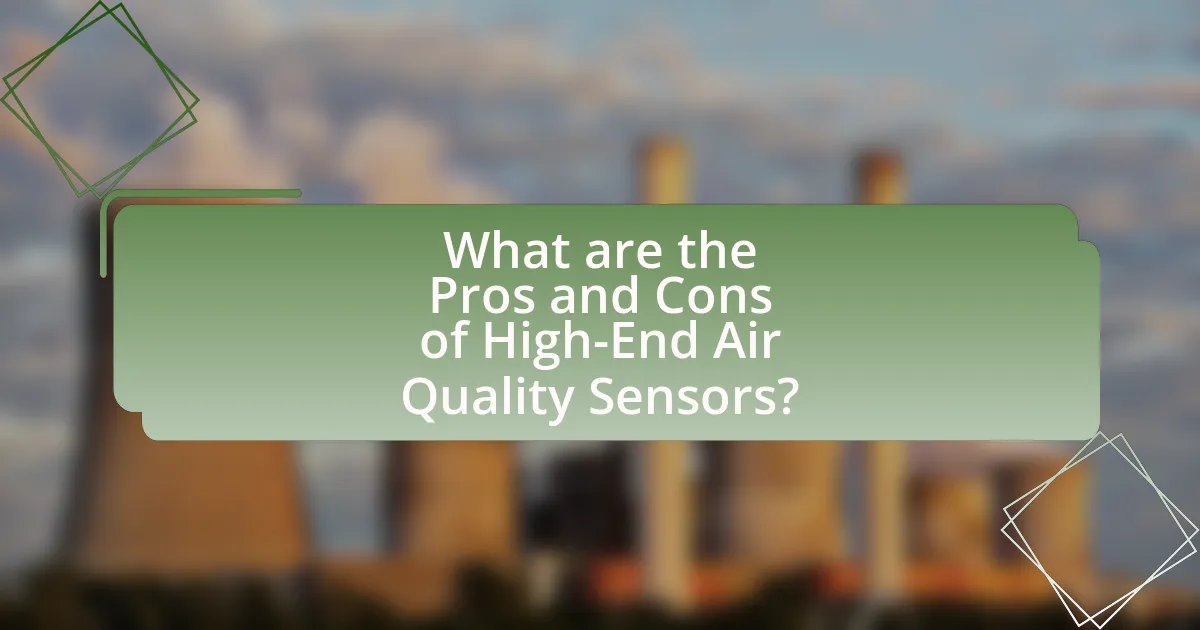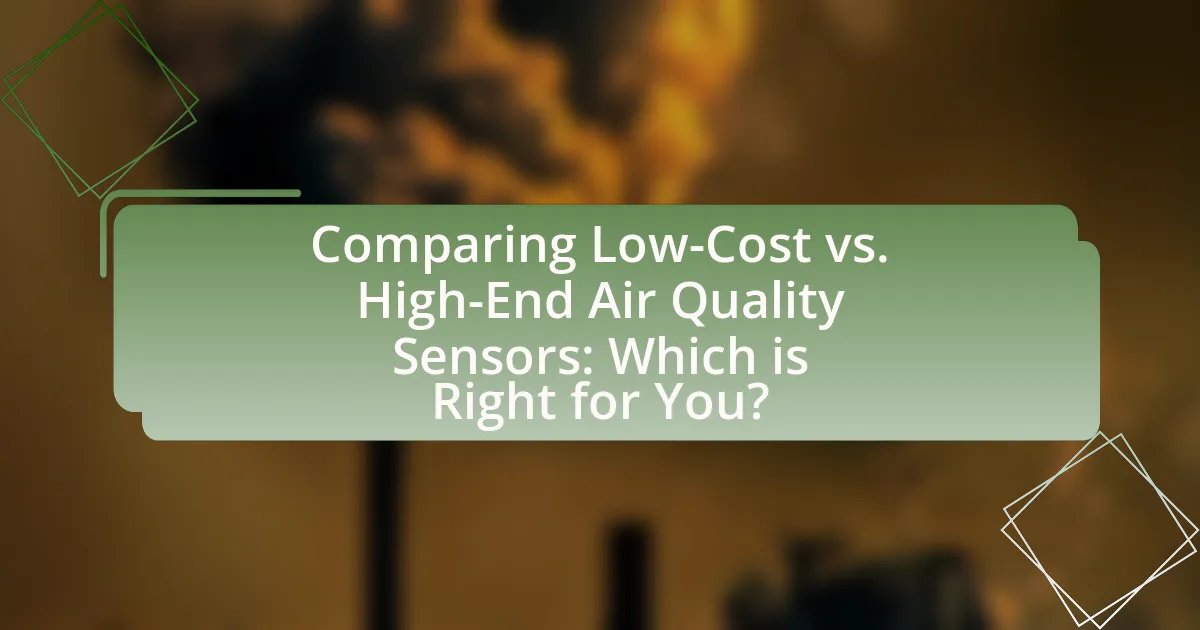The article focuses on comparing low-cost and high-end air quality sensors, highlighting their differences in technology, accuracy, and functionality. Low-cost sensors are affordable and suitable for general monitoring, while high-end sensors offer advanced features, higher precision, and real-time data analysis, making them ideal for professional applications. Key considerations for selecting a sensor include performance, durability, and user needs, with an emphasis on understanding the trade-offs between cost and data reliability. The article also discusses the technologies used in both types of sensors, their respective advantages and limitations, and best practices for effective usage.
What are Low-Cost and High-End Air Quality Sensors?

Low-cost air quality sensors are affordable devices designed to measure air pollutants and environmental conditions, typically using simpler technology and offering basic functionality. In contrast, high-end air quality sensors provide advanced measurement capabilities, higher accuracy, and often include features such as real-time data analysis and integration with other systems. For example, low-cost sensors may use electrochemical methods for detecting gases, while high-end sensors often employ laser-based technologies for particulate matter detection, resulting in more reliable data.
How do Low-Cost Air Quality Sensors differ from High-End Models?
Low-cost air quality sensors differ from high-end models primarily in accuracy, sensitivity, and data reliability. Low-cost sensors often use less sophisticated technology, resulting in lower precision and a higher likelihood of false readings, while high-end models typically employ advanced sensors and calibration techniques that provide more accurate and reliable data. For instance, a study published in the journal “Environmental Science & Technology” found that low-cost sensors could have an error margin of up to 50% compared to high-end models, which are calibrated against reference standards. This discrepancy highlights the importance of selecting the appropriate sensor type based on the required accuracy for specific applications.
What technologies are commonly used in Low-Cost Air Quality Sensors?
Low-cost air quality sensors commonly utilize technologies such as metal oxide semiconductor (MOS) sensors, electrochemical sensors, and optical sensors. MOS sensors detect gases like carbon monoxide and volatile organic compounds through changes in electrical resistance, making them cost-effective and widely used in portable devices. Electrochemical sensors measure specific gas concentrations by generating a current in response to chemical reactions, providing accurate readings for pollutants like ozone and nitrogen dioxide. Optical sensors, often based on light scattering principles, are employed to measure particulate matter levels, offering a reliable method for assessing air quality. These technologies collectively enable low-cost sensors to deliver essential air quality data while maintaining affordability and accessibility.
What advanced features are found in High-End Air Quality Sensors?
High-end air quality sensors typically include advanced features such as multi-gas detection, real-time data analytics, and high sensitivity to particulate matter. These sensors can measure a wide range of pollutants, including volatile organic compounds (VOCs), carbon dioxide (CO2), and nitrogen dioxide (NO2), providing comprehensive air quality assessments. Additionally, many high-end models offer connectivity options like Wi-Fi or Bluetooth for remote monitoring and integration with smart home systems, enhancing user accessibility and data management. The accuracy of these sensors is often validated through calibration against recognized standards, ensuring reliable performance in various environments.
Why is it important to compare Low-Cost and High-End Air Quality Sensors?
Comparing low-cost and high-end air quality sensors is important to understand the trade-offs between affordability and accuracy. Low-cost sensors often provide basic measurements suitable for general awareness, while high-end sensors offer precise data essential for scientific research and regulatory compliance. For instance, a study published in Environmental Science & Technology found that low-cost sensors can have significant variability in readings compared to reference-grade instruments, highlighting the need for careful selection based on intended use. This comparison helps consumers and researchers choose the appropriate sensor based on their specific needs, budget constraints, and the required level of data reliability.
What factors should be considered when choosing between Low-Cost and High-End options?
When choosing between low-cost and high-end options, key factors include performance, durability, features, and support. Performance is critical as high-end options typically offer more accurate and reliable measurements, which is essential for air quality sensors. Durability matters because high-end models often use superior materials, ensuring longer lifespan and better resistance to environmental factors. Features such as data logging, connectivity, and user interface can significantly enhance usability, with high-end options generally providing advanced functionalities. Lastly, customer support and warranty services are often more robust for high-end products, providing peace of mind for users.
How do user needs influence the choice of sensor type?
User needs significantly influence the choice of sensor type by determining the required accuracy, sensitivity, and specific application of the sensor. For instance, individuals or organizations seeking precise air quality measurements for regulatory compliance will opt for high-end sensors that provide reliable data, while casual users may choose low-cost sensors for general monitoring. Research indicates that high-end sensors often feature advanced technologies, such as laser-based detection, which are essential for applications requiring stringent data quality, whereas low-cost sensors may suffice for personal use or educational purposes, where budget constraints are a priority.
What are the Pros and Cons of Low-Cost Air Quality Sensors?

Low-cost air quality sensors offer both advantages and disadvantages. The primary advantage is affordability, making air quality monitoring accessible to a wider audience, including individuals and small organizations. These sensors can provide real-time data on pollutants, enabling users to make informed decisions about their environment. However, the main disadvantage is that low-cost sensors often lack accuracy and reliability compared to high-end models. Studies have shown that many low-cost sensors can have significant calibration issues, leading to inconsistent readings. For instance, a study published in Environmental Science & Technology found that low-cost sensors could have errors exceeding 50% when measuring particulate matter. This discrepancy can mislead users about air quality conditions, potentially impacting health decisions.
What advantages do Low-Cost Air Quality Sensors offer?
Low-cost air quality sensors offer affordability, accessibility, and the ability to provide real-time data on air pollution levels. These sensors enable widespread deployment in various environments, allowing communities to monitor air quality without significant financial investment. For instance, a study by the University of California, Berkeley, found that low-cost sensors can effectively measure particulate matter and volatile organic compounds, making them valuable tools for citizen science and public health initiatives. Their ease of use and integration with mobile technology further enhance their utility, empowering individuals and organizations to take informed actions regarding air quality.
How do affordability and accessibility impact user adoption?
Affordability and accessibility significantly enhance user adoption by lowering financial barriers and ensuring that products are reachable for a wider audience. When air quality sensors are priced affordably, more consumers can purchase them, leading to increased market penetration. For instance, a study by the International Journal of Environmental Research and Public Health found that lower-cost sensors can increase public awareness and engagement with air quality issues, as they become accessible to various socioeconomic groups. This accessibility fosters a greater understanding of air quality, encouraging users to adopt these technologies for personal and community health monitoring.
What are the limitations of Low-Cost Air Quality Sensors?
Low-cost air quality sensors have several limitations, primarily related to accuracy, calibration, and data reliability. These sensors often use less sophisticated technology, resulting in lower precision and higher susceptibility to environmental factors, such as temperature and humidity, which can skew readings. Additionally, many low-cost sensors lack the ability to be calibrated against reference standards, leading to inconsistent data over time. Studies have shown that these sensors can exhibit significant variability in measurements compared to high-end counterparts, with discrepancies sometimes exceeding 50% for certain pollutants. Furthermore, low-cost sensors may not detect all relevant air quality parameters, limiting their usefulness in comprehensive air quality assessments.
In what scenarios are Low-Cost Air Quality Sensors most effective?
Low-Cost Air Quality Sensors are most effective in community monitoring, educational settings, and preliminary research. In community monitoring, these sensors provide accessible data on air quality, enabling residents to understand pollution levels and advocate for cleaner air. In educational settings, they serve as hands-on tools for students to learn about environmental science and data collection. For preliminary research, low-cost sensors allow researchers to gather initial data on air quality trends without significant financial investment, facilitating larger studies. Studies have shown that while these sensors may lack the precision of high-end models, they can still provide valuable insights when used in appropriate contexts.
What types of environments benefit from using Low-Cost Sensors?
Low-cost sensors are particularly beneficial in environments such as urban areas, industrial sites, and rural communities. These environments often require extensive monitoring of air quality due to high pollution levels, industrial emissions, or agricultural activities. For instance, urban areas can utilize low-cost sensors to gather real-time data on air pollutants, enabling quicker responses to air quality issues. Additionally, rural communities can benefit from low-cost sensors to monitor agricultural impacts on air quality, providing valuable data for environmental management. The affordability of these sensors allows for widespread deployment, making it feasible to collect data across diverse locations and conditions, which is essential for effective environmental monitoring and public health initiatives.
How can Low-Cost Sensors be integrated into personal or community monitoring efforts?
Low-cost sensors can be integrated into personal or community monitoring efforts by deploying them in various locations to collect real-time environmental data, such as air quality metrics. These sensors are affordable and can be easily distributed among community members or placed in public areas, enabling widespread data collection. For instance, a study by the University of California, Berkeley, demonstrated that low-cost air quality sensors could effectively complement traditional monitoring stations, providing localized data that reflects community-specific pollution levels. This integration allows for enhanced public awareness and engagement, as individuals can access real-time data through mobile applications or community platforms, fostering a proactive approach to environmental health.
What are the Pros and Cons of High-End Air Quality Sensors?

High-end air quality sensors offer precise measurements and advanced features, but they also come with higher costs and complexity. The advantages include superior accuracy, the ability to detect a wider range of pollutants, and often enhanced data analysis capabilities, which are crucial for informed decision-making regarding air quality. For instance, high-end sensors can measure particulate matter, volatile organic compounds, and gases like carbon dioxide and ozone with high reliability, making them suitable for both residential and industrial applications. However, the disadvantages include their significant financial investment, potential overkill for basic needs, and the requirement for regular calibration and maintenance, which can complicate usage for non-experts.
What benefits do High-End Air Quality Sensors provide?
High-end air quality sensors provide superior accuracy and reliability in measuring air pollutants. These sensors utilize advanced technology, such as laser-based detection and multi-gas analysis, which allows them to detect a wider range of contaminants, including particulate matter, volatile organic compounds, and carbon dioxide, with high precision. For instance, studies have shown that high-end sensors can achieve an accuracy rate of over 90% in detecting specific pollutants, compared to lower-cost alternatives that may only reach 70% accuracy. Additionally, high-end sensors often feature real-time data reporting and integration capabilities with smart home systems, enhancing user experience and enabling proactive health measures.
How do High-End Sensors ensure accuracy and reliability?
High-end sensors ensure accuracy and reliability through advanced calibration techniques, high-quality materials, and sophisticated algorithms. These sensors often undergo rigorous testing and calibration against known standards, which minimizes measurement errors. For instance, many high-end sensors utilize multiple sensing technologies, such as electrochemical and optical methods, to cross-verify data, enhancing overall reliability. Additionally, they are designed to operate under a wide range of environmental conditions, maintaining performance consistency. This combination of precise engineering and robust validation processes contributes to their superior accuracy and reliability compared to low-cost alternatives.
What additional features enhance the user experience with High-End Sensors?
High-end sensors enhance user experience through advanced features such as real-time data analytics, higher accuracy, and multi-parameter measurement capabilities. These sensors often provide detailed insights into air quality by measuring various pollutants simultaneously, which allows users to make informed decisions about their environment. Additionally, high-end sensors typically include user-friendly interfaces and connectivity options, such as mobile app integration and cloud data storage, enabling users to access and analyze data conveniently. The precision of high-end sensors is supported by their use of sophisticated calibration techniques and high-quality materials, ensuring reliable performance over time.
What are the potential drawbacks of High-End Air Quality Sensors?
High-end air quality sensors can be expensive, which may limit accessibility for some users. The high cost often includes advanced features and precision, but this can lead to budget constraints for individuals or organizations. Additionally, these sensors may require regular calibration and maintenance, increasing long-term operational costs. Furthermore, high-end sensors can produce complex data that may be challenging for non-experts to interpret effectively, potentially leading to misinformed decisions regarding air quality management.
How does the cost of High-End Sensors affect their accessibility?
The cost of high-end sensors significantly limits their accessibility, as higher prices restrict the ability of individuals and organizations to purchase them. For instance, high-end air quality sensors can range from several hundred to thousands of dollars, making them financially unfeasible for many potential users, especially in low-income communities or small businesses. This financial barrier results in a disparity in access to advanced monitoring technology, which can hinder efforts to improve air quality and public health in underserved areas.
In what situations might High-End Sensors be overkill?
High-end sensors may be overkill in situations where air quality monitoring requirements are minimal or basic. For instance, in residential settings where general air quality trends are sufficient, low-cost sensors can provide adequate data without the need for the advanced features and precision of high-end models. Additionally, in environments with stable air quality, such as rural areas with low pollution levels, the enhanced sensitivity and specificity of high-end sensors may not justify their higher cost.
How can you determine which type of Air Quality Sensor is right for you?
To determine which type of air quality sensor is right for you, assess your specific needs, such as the pollutants you want to monitor, the required accuracy, and your budget. Low-cost sensors typically measure basic pollutants like particulate matter and volatile organic compounds but may lack precision and reliability. In contrast, high-end sensors offer advanced features, greater accuracy, and the ability to detect a wider range of pollutants, making them suitable for professional or health-sensitive environments. Research indicates that low-cost sensors can vary significantly in performance, with some studies showing discrepancies in readings compared to reference-grade instruments, highlighting the importance of selecting a sensor that aligns with your monitoring goals and environmental conditions.
What are the key considerations when selecting an Air Quality Sensor?
When selecting an air quality sensor, key considerations include measurement accuracy, sensor type, range of pollutants detected, calibration frequency, and data output options. Measurement accuracy is crucial as it determines the reliability of the data collected; for instance, high-end sensors often provide more precise readings compared to low-cost alternatives. The type of sensor, such as electrochemical or optical, affects the sensor’s response to different pollutants, influencing its suitability for specific applications. The range of pollutants detected is also important; some sensors may only measure particulate matter, while others can detect gases like CO2, VOCs, and NO2. Calibration frequency impacts the long-term reliability of the sensor, with high-end models typically requiring less frequent calibration. Finally, data output options, including real-time monitoring and integration with IoT systems, enhance usability and data accessibility, making them essential for effective air quality management.
How do your specific needs and budget influence your choice?
Your specific needs and budget significantly influence your choice of air quality sensors by determining the features you prioritize and the price range you can afford. For instance, if you require advanced features like real-time data analysis and high accuracy, you may lean towards high-end sensors, which typically cost more but offer better performance. Conversely, if your budget is limited and your needs are basic, low-cost sensors may suffice, providing essential data without the advanced functionalities. Research indicates that consumers often balance their requirements against their financial constraints, leading to a decision that aligns with both their immediate needs and long-term investment goals.
What resources are available to help you make an informed decision?
Resources available to help make an informed decision about air quality sensors include product reviews, comparison articles, and user testimonials. Product reviews from reputable sources like Consumer Reports provide detailed evaluations of sensor performance, accuracy, and reliability. Comparison articles often highlight the differences in features, costs, and intended use cases between low-cost and high-end sensors, aiding in understanding the trade-offs. User testimonials on platforms like Amazon or specialized forums offer real-world insights into the effectiveness and usability of various models, helping potential buyers gauge satisfaction levels.
What are some best practices for using Air Quality Sensors effectively?
To use air quality sensors effectively, ensure proper placement in areas with good air circulation and away from obstructions. This practice enhances the accuracy of readings, as sensors require unobstructed airflow to detect pollutants accurately. Additionally, regularly calibrate the sensors according to the manufacturer’s guidelines to maintain precision in measurements. Research indicates that calibration can significantly reduce measurement errors, ensuring reliable data collection. Furthermore, consider integrating multiple sensors to capture a comprehensive view of air quality across different locations, as this approach provides a more complete understanding of environmental conditions.

Leave a Reply